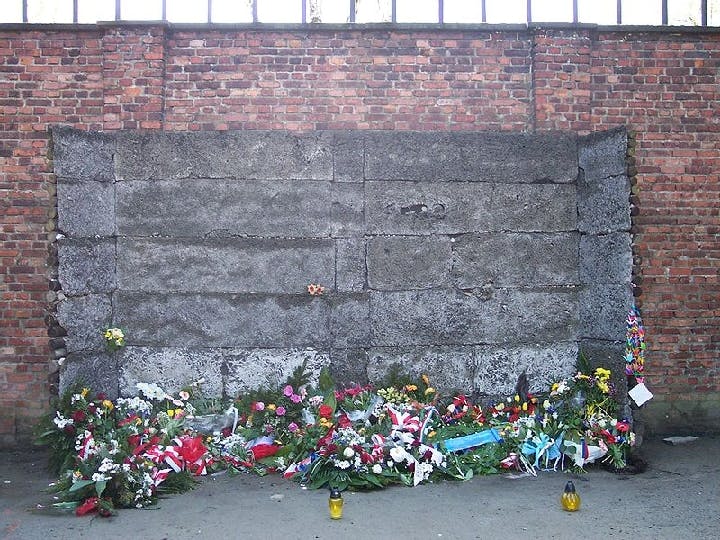Winter 2014
Touring Auschwitz as a Survivor
– The Wilson Quarterly
Some Holocaust survivors have returned to the concentration camps, this time as visitors.
Rena Chernoff survived Auschwitz, and she dreaded returning to the concentration camp even in its present incarnation as a museum. Her adult children wanted to see it, however, so in 1992 she went with them.
She decided to go not as a victim or even as a Jew, writes Tim Cole, professor of social history at the University of Bristol, England, but simply as an American sightseer checking off one more destination on a European tour. She imagined her American sneakers, she said in an interview, would be like the ruby-encrusted shoes Dorothy donned in The Wizard of Oz, “those slippers that save you.”
Once Chernoff arrived in Poland, her plan to remain aloof fell apart. She found herself shifting between the roles of a woman mourning family who had died there, a guide for her husband and children, and an “American Jew concerned about the contemporary politics of memory” after she was dismayed to find that a cross had been erected on the grounds to commemorate Christian victims. Cole is working on a book about survivors’ returns to “holocaust landscapes,” and he notes in History & Memory that Chernoff’s visit was similar to that of many other survivors. As they make their way through various “micro-sites” in the compound — notably the crematoria, barracks, and gateway — their roles change.
While returning survivors are already horribly familiar with some areas of Auschwitz, most encounter the gas chambers and crematoria for the first time. These sites, along with a nearby lake where ashes of the dead were dumped, serve as a “cemetery in lieu of the family graves that simply do not exist.” They are places where one can symbolically lay to rest the family and friends murdered in the camp, places where “the act of mourning can be ... interpreted as a posthumous victory of sorts.” Survivors often say Kaddish, the Jewish prayer of mourning. Some light candles. One woman took stones from the crematoria; a man who visited in 1946, a year after the liberation of the camps, collected ashes, secretly keeping a flask of them for 50 years.
As mourners, the survivors who visit tend to seek solitude in the crematoria, but moving to the barracks, they often find themselves becoming expert witnesses, telling family members, fellow tourgoers, and even tour guides what the experience was really like.
“For survivors, being able to walk freely in and out of the gateway is hugely symbolic”
“Conflict between official museum guides and returning survivors” is a recurring theme of visitors’ accounts, Cole observes. This was the case “particularly in the 1980s and 1990s, when the stories told at Auschwitz emphasized Polish victimhood” despite the predominance of Jews among those imprisoned and murdered there. Walking among the bunks they’d actually slept in, survivors who had previously determined to silently take in the tour felt compelled to set the record straight or to implore others to envision the place filled with people. “I showed them everything in Auschwitz,” one said. “We find my name scraped in ... in the wall, in the wall.”
There are good arguments against using Holocaust tourism to achieve closure. Art historian Griselda Pollock has cautioned that doing so denies that the concentration camp was anything but a “factory of death, a place from which none was intended to return,” and that “to go, to tour and to leave, is to defy that demonic logic, to put ‘Auschwitz’ back in a place with an entrance and an exit.”
The fact remains that for survivors, being able to walk freely in and out of the gateway is hugely symbolic. The Nazis’ victims at Auschwitz were dragged into the camp through its gateway, and those who survived were marched out by American troops in 1945, passive participants in their own liberation. Touching barbed wire that once pulsed with electricity, standing in watchtowers where Nazi guards stood, is a way to confront past tormentors. “Look, we are back,” one survivor imagined saying to the Nazis. “We’ve got our own families.”
For many visitors, however, the visit is not as satisfying as they had hoped, for the very reason that Auschwitz has been transformed — or, as some see it, sanitized. Summer grass grows over places once covered in mud. “Believe you me, if there was one blade of grass you know what would have happened, you would have eaten it,” one woman explained to her son.
In wintertime, bitter cold and biting wind restore a measure of verisimilitude, but the air is silent, scrubbed of the cries of children and the stench of smoke. Some visitors conjure this other geography, sensing blood and bones in the grass and burning flesh in the air, finding the landscape of memory truer, even more viscerally felt, than the material one before them.
Others refuse to make the journey to Auschwitz. “I will never go back to any camp, and I can’t,” survivor William Lowenberg insisted. “I’m afraid to wake up, really wake up. And since I’m having a very good normal life, and I think I can function quite well, I believe, maybe not everyone agrees with me, but I agree with me on that issue, I don’t want potential interference. ... It’s very deeply buried, it’s very deeply buried, and let’s leave it that way for the time being at least.”
THE SOURCE: “Crematoria, Barracks, Gateway” by Tim Cole, History & Memory, Fall/Winter 2013.
Photo courtesy of Wikimedia Commons
